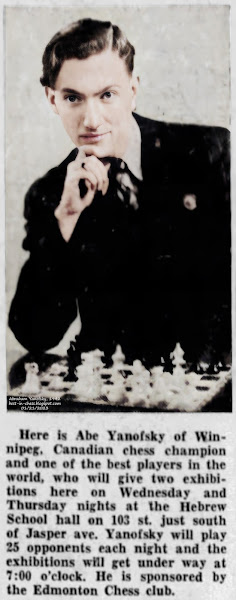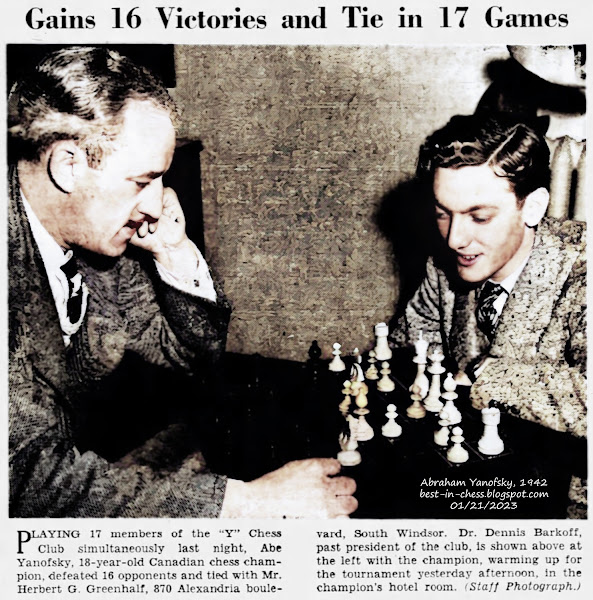1942
April 28 1942
Edmonton Journal, Edmonton, Alberta, Canada, Tuesday, April 28, 1942
Here is Abe Yanofsky of Winnipeg, Canadian chess champion and one of the best players in the world, who will give two exhibitions here on Wednesday and Thursday night at the Hebrew School hall on 103 st. just south of Jasper ave. Yanofsky will play 25 opponents each night and the exhibitions will get under way at 7:00 o'clock. He is sponsored by the Edmonton Chess club.
April 30 1942
Edmonton Journal, Edmonton, Alberta, Canada, Thursday, April 30, 1942
Abe Yanofsky Has Busy Time, Losing Two Chess Games
Opposed by 24 crack players, Canadian Chess Champion Abe Yanofsky won 19, lost two and drew three, in exhibition matches at the Hebrew school hall Wednesday night. In the above layout, Yanofsky is shown walking around the tables, making his moves. Below is a close up of the 18-year-old Winnipeg chess wizard, rated one of the world's best players.
Edmonton Journal, Edmonton, Alberta, Canada, Thursday, April 30, 1942
 Wins 19, Held to Draw in 3 During Six-Hour Exhibition 30 Apr 1942, Thu Edmonton Journal (Edmonton, Alberta, Canada) Newspapers.com
Wins 19, Held to Draw in 3 During Six-Hour Exhibition 30 Apr 1942, Thu Edmonton Journal (Edmonton, Alberta, Canada) Newspapers.com
Wins 19, Held to Draw in 3 During Six-Hour Exhibition
Yanofsky Plays Again Tonight
Playing 24 opponents tonight at the Hebrew school on 103 st. just south of Jasper ave., Canadian Chess Champion Abe Yanofsky of Winnipeg will endeavor to make a clean sweep. The exhibitions this evening will start at 7:00 o'clock.
Last night, in the opening series of matches, Yanofsky won 19, lost two and drew in three.
A good crowd was present for the matches last night which lasted nearly six hours. It was the first time that the youthful Yanofsky has suffered defeat in a Canadian city since he has been the champion.
“I certainly can agree that Edmonton has very fine chess club,” offered Champion Yanofsky at the close of Wednesday night's play.
Walter Holowach and Charles Kirton Triumph Over Champion
YOUNGSTER GOOD
Canadian chess champion Abe Yanofsky suffered two defeats, was held to three draws and won 19 games in exhibition matches staged at the Hebrew school hall Wednesday night. The play lasted for six hours and it was the first time since Yanofsky became the Canadian champion that he has lost two games in a night's play.
Walter Holowach, of this city, the provincial chess champion, scored one of the victories over the distinguished visitor, while Charles Kirton, also of Edmonton, counted the other victory.
E. S. Barker, H. S. Hegler, and Gordon Pretty all had draws, the game between Yanofsky and Pretty lasting four hours before stalemate was reached.
Yanofsky, who was playing 24 games simultaneously, walked his appointed way on the inside of the rectangle of tables at which sat his 24 opponents. Only 18 and a native of Winnipeg, young Abe was quite at ease at the start.
Had Early Problems
During the early part of his exhibition the champion's speed in walking was consistently steady, but as the middle-game period drew near, it was observed that a quick stop here and there was necessary as Yanofsky noticed a position that demanded a measure of mental concentration.
A few players departed from the “book” plays in an effort to upset any preconceived plan of the champion's. Spectators noticed that players were consulting one and other, but usually they failed to ruffle the champion and the results they obtained were zero.
The process of elimination went steadily on and after 10:00 p.m. (the matches started at 7:00 p.m.) many of Yanofsky's opponents had resigned. He was accompanied on his travels around the tables by President D. T. David of the Edmonton Chess club and executive members, all of whom were acting in the capacity of referees.
New Chess Find
One of the night's highlights was the performance of 10-year-old Harry Brody who has been playing only three months. His tutor, N. Silin, was extremely well pleased as young Harry kept the champion going for about 30 moves. It was a remarkable performance for such a young player.
“Harry lives at 9523 103 ave., and reads and studies the chess works of the present world's champion, Dr. Alekhine, and also those of the no less renowned Capablanca and Sznosko-Borofsky,” said Secretary George Grant of the Edmonton Chess club when asked about Master Brody's play.
“He loves the game of chess,” concluded Secretary Grant, “as much as he does his violin. Thirty moves against Yanofsky is excellent playing.”
The Hon. Dr. W. W. Cross, minister of health, and Dr. J. L. Robinson, M. L. A. for Medicine Hat, were present for all the games.
The following were opponents of Champion Yanofsky last night:
W. Holowach, C. H. Erickson, J. G. Neddrie, R. Christensen, S. Tougas, R. G. Pretty, C. L. Kirton, A. Skrepnek, J. W. Barnett, H. S. Hegler, Mrs. G. Grant, R. Campbell, P. Melnychuk, A. Jackson, J. Clegg, E. S. Barker, P. Denisuk, Dr. J. L. Robinson, A. Shnitka, E. Levant, AC1. H. A. Bricker, S. Fogelson, M. Shapiro, Harry Brody.
May 14 1942
The Windsor Star, Windsor, Ontario, Canada, Thursday, May 14, 1942.
Gains 16 Victories and Tie in 17 Games
PLAYING 17 members of the “Y” Chess Club simultaneously last night, Abe Yanofsky, 18-year-old Canadian chess champion, defeated 16 opponents and tied with Mr. Herbert G. Greenhalf, 870 Alexandria boulevard, South Windsor. Dr. Dennis Barkoff, past president of the club, is shown above at the left with the champion, warming up for the tournament yesterday afternoon, in the champion's hotel room. (Staff photograph.)
The Windsor Star Windsor, Ontario, Canada, Thursday, May 14, 1942
 Chess Champ Says Axis Has Five More 'Moves' 14 May 1942, Thu The Windsor Star (Windsor, Ontario, Canada) Newspapers.com
Chess Champ Says Axis Has Five More 'Moves' 14 May 1942, Thu The Windsor Star (Windsor, Ontario, Canada) Newspapers.com
Chess Champ Says Axis Has Five More Moves
ABE YANOFSKY FEELS ALLIED STRATEGY IN GIGANTIC GAME WILL BRING VICTORY
By ROSS MASON
All the worlds a gigantic chess board to 18-year-old Canadian chess champion Abe Yanofsky of Winnipeg, who came to Windsor yesterday to play an exhibition match simultaneously with 17 opponents at the “Y”. The Allies are playing the “French defence” system. The axis have selected the “Danish gambit.” And there the axis will be proven to have made their mistake.
MAKE FLASHY START
For the war chess game selected by Hitler and his cohorts is flashy, brilliant, and gives the first appearance of being a winning system of attack. Pieces are sacrificed irrespectively of the cost of sacrifice to gain in attack. For 15 moves the Danish gambit player appears to be winning. Then suddenly his opponent sweeps in and cleans out.
The axis has 10 moves of their 15, the chess champion estimates. Five more moves. Then—wham! The black has moved in, backed by accumulated power. The white is no more. Black has won decisively.
The Allies have chosen the one method of playing which begins passively. Black gives up his centre men in the beginning, but afterward storms the centre of the board and regains it. This is the best defence, Abe says. If the opponent tries to win, he loses. The axis will find that in war it is true as in chess.
LINKED TO WAR STRATEGY
His comparison to the war field as a gigantic chess board has historic foundation, he says. For in the early days, kings who began the game planned their battles cautiously on a chess board. Some of them had huge boards drawn up in their gardens, and played with live pieces.
The entire game has a setup of state. The pawns are the infantry. The castle represents armament. The knights are officers. The bishop represents the church. The king and queen represent royalty.
And Abe is pretty sure, having tied current events down to a monumental chess game with life or death as the award to the winner, that Herr Hitler and his playmates have just five more moves to make and the game will be over for them.
Campaigns of both sides follow chess campaigns laid down through the ages exactly, he says.
HES GOOD AT GAME
And this 18-year-old Winnipeg lad who began chess when little more than 10 years of age, knows whereof he speaks. Several days ago he played 20 opponents in London at one time. He made 800 moves in two hours, at about one move per nine seconds, and won 18 games, drew one, and lost only one.
Son of Mrs. Mary Yanofsky, he saw his first chess set when ten years of age, in a store window. Curious, he asked his father, who died four years ago, what the game was. His father bought him a set. He learned to play in half an hour and the rest is brilliant history.
At 11 years of age, he was boys' champion of Canada, competing against young men of 18. He was also holder of the Major Championship for Canada, won in competition with men of ail ages.
At 12, Abe was champion of Manitoba, a title he has never lost. At 13 he tied for fourth place in the Canadian championships held in Quebec. At 14 he tried for the Canadian championship at Toronto, and lost by one game. At 15 he played in New York and won the consolation tournament, losing a championship on the toss of a coin.
 Chess Star Gives Views 14 May 1942, Thu The Windsor Star (Windsor, Ontario, Canada) Newspapers.com
Chess Star Gives Views 14 May 1942, Thu The Windsor Star (Windsor, Ontario, Canada) Newspapers.com
VICTORY IN ARGENTINA
At 15 too, he was selected as a member of a five-man team to represent Canada at a tournament sponsored by the government of the Argentine. He played against representatives of 56 countries, among them Poland, Germany, France, England, Ireland, Belgium, Estonia, Palestine, Sweden, Norway. The Canadian team won the tournament. He was decorated by the Argentine government for this achievement.
Chess is his hobby. His real interest is medicine, in which he is a second year student. Chess helps pay for his tuition. Some day he hopes to be the champion of the world, but he'd rather be a good doctor.
Playing 20 opponents at a time, going from one table to another making definite whirlwind plays is no novelty to him. When he was 11, he played against 25 opponents and won 18 of the games.
As he settled down yesterday, playing brilliantly while being interviewed, he ran his hands over the men on his side.
Hitler is the king on the board. He does least work and gets the most protection, he smiled. The queen is the head of the army, does all the work and gets the least credit. The axis game of Danish gambit he has chosen to play will last successfully for about five more moves. Then watch what happens.



























